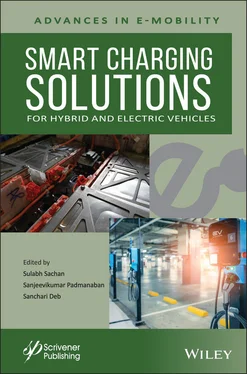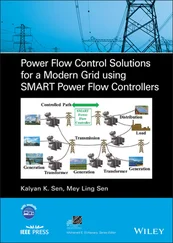Smart Charging Solutions for Hybrid and Electric Vehicles
Здесь есть возможность читать онлайн «Smart Charging Solutions for Hybrid and Electric Vehicles» — ознакомительный отрывок электронной книги совершенно бесплатно, а после прочтения отрывка купить полную версию. В некоторых случаях можно слушать аудио, скачать через торрент в формате fb2 и присутствует краткое содержание. Жанр: unrecognised, на английском языке. Описание произведения, (предисловие) а так же отзывы посетителей доступны на портале библиотеки ЛибКат.
- Название:Smart Charging Solutions for Hybrid and Electric Vehicles
- Автор:
- Жанр:
- Год:неизвестен
- ISBN:нет данных
- Рейтинг книги:4 / 5. Голосов: 1
-
Избранное:Добавить в избранное
- Отзывы:
-
Ваша оценка:
- 80
- 1
- 2
- 3
- 4
- 5
Smart Charging Solutions for Hybrid and Electric Vehicles: краткое содержание, описание и аннотация
Предлагаем к чтению аннотацию, описание, краткое содержание или предисловие (зависит от того, что написал сам автор книги «Smart Charging Solutions for Hybrid and Electric Vehicles»). Если вы не нашли необходимую информацию о книге — напишите в комментариях, мы постараемся отыскать её.
The most comprehensive and up-to-date study of smart charging solutions for hybrid and electric vehicles for engineers, scientists, students, and other professionals. Smart Charging Solutions for Hybrid and Electric Vehicles:
Smart Charging Solutions for Hybrid and Electric Vehicles — читать онлайн ознакомительный отрывок
Ниже представлен текст книги, разбитый по страницам. Система сохранения места последней прочитанной страницы, позволяет с удобством читать онлайн бесплатно книгу «Smart Charging Solutions for Hybrid and Electric Vehicles», без необходимости каждый раз заново искать на чём Вы остановились. Поставьте закладку, и сможете в любой момент перейти на страницу, на которой закончили чтение.
Интервал:
Закладка:
Smart charging of EVs supports the convergence of EV owners’ behavior and requirements, charging, the grid, and all participants involved in the system. Support is provided by various system enablers, which include supporting technologies, policies, and stakeholders. The benefits of smart charging extend to the efficient management of charging during peak and off-peak load hours, increased penetration of renewable energy, reduced transmission losses, economic and technical benefits to users, and much more [1, 4-6]. The smart charging system will unleash more benefits when the users’ and service providers’ requirements are a defined set of operational standards that are coherently aligned.
The literature presents a broader range of developments in the smart charging systems [5, 7]. Most of the works are on developing algorithms to either maximize, minimize, or compute an optimal parameter to define an efficient working of the smart charging system. Although it is desirable to approach the smart charging system’s design to inculcate the interests of all the stakeholders, most of the work did not consider the evolution of the market or the competitiveness of service providers and their outlooks [8].
Cars in general and EVs spend more than 90% of their lifetime parked. The parking period can be used for a variety of purposes, such as local energy storage, mobile energy storage, backup support to homes and buildings, active power support to the utility grid, ancillary services support, and much more. The services rendered by EVs generate income for the EV users as well. An EV can effectively be customized for both mobility and micro-grid connected systems. Apart from the mentioned services, EVs support renewable integration as well. The power generated from renewables is intermittent but attractive as the contribution of carbon emissions in this generation is reduced drastically. The EVs, when used as local energy storage devices, act as a bridge between the utility grid and renewables.
Smart charging also renders a fascinating opportunity to scale-up, improve reliability, automate operation monitoring and control, and overhaul the existing power systems. Although the increased penetration of EVs has a serious impact on the operation of the utility grid, the added potential of EVs with goals of smart charging make the power system flexible at the consumer end, as well as to the power system operator and connected entities. This chapter will focus on the various aspects of dealing with increased penetration of EVs using smart charging. Worldwide, the definition and context of “smart” may vary depending on the requirements of the users. The next subsection will introduce the context of “smart” and describe various approaches to develop a smart system.
1.1.1 Context of SMART
The term “smart” is the most commonly added word to every application, service, and technology in recent times. The context of “smart” varies based on the definition of the manufacturer, user, and the objectives for which the application, services, and technology are developed. Any product that implies making life simpler and better than its previous counterpart is termed as “smart”. Hence, defining the context of “smart” is utterly dependent on added functionalities in a product. The functionalities may include intelligence in operation, internet connectivity in devices such as IoT, data-driven operation and analysis, learning capabilities from the deployed environment, communication between devices or entities of a system, or a combination of any or all the mentioned functionalities.
The term “smart” originates from an acronym: Self-Monitoring, Analysis, and Reporting Technology. “Smart” technologies can be broadly categorized in the following ways:
1 a. Smart automation devices are devices automated by programming and learning data to operate based on an intuitive interface included in the smart automation device. A geyser that operates at a particular interval of time to heat water automatically considering the environment’s ambient temperature is an example of a smart automation device.
2 b. Smart software devices are application based and programmed to perform analytics, display data to the user, request data from the connected subsystems in a system, or any other functionalities for which it is programmed. Such devices mostly require internet connectivity or any communication link between the connected subsystems. An example of a smart software device is an application installed in a computing system to control and monitor a factory’s operation. Smart software devices are considered to be easily scalable and upgradeable.
3 c. Smart hardware devices, as the name suggests, include remotely connected, monitored, and operated devices. Such devices mostly require a software-based user interface and connectivity using any communication technology to monitor and operate. Smart appliances at homes, such as smart bulbs, are one of the examples of a smart hardware device.
4 d. Smart computational environment: Computational environment in recent days has upgraded diversely but converges to a common theme of “smart”. The environment here refers to all the connected devices or smart devices in a system that give a platform to the user to develop and execute an operation for which the environment is proficient. The operation’s development and execution is made possible by establishing necessary communication between each internal device and required external entities. The IBM Cloud, Microsoft Azure, and Google Cloud are examples of a smart computational environment. Users have access to a variety of applications and devices that can be configured as required.
The categorization of “smart” devices is broad and not limited to the types mentioned earlier. Enhancement in existing technologies and new developments have shown vast possibilities of making existing devices smart and accessible. The addition of smart functionalities in any system should increase product capabilities, utilization, reliability, and transcend conventional product boundaries.
The context of smart charging is an amalgamation of all the “smart” technologies. The smart charging infrastructure involves the need of automation devices, software run devices, and supporting software, hardware devices, and the computational environment. Each of the mentioned entities is built with intelligence added by various algorithms that help make relevant decisions and implement them.
Any “smart” system requires proper coordination while developing and operating. The next subsection briefly explains approaches taken by the developers to ensure the addition of functionalities, which make the system smart and reliable to the users and renders market value to the developers.
1.1.2 Approaches
The paradigm of “smart” is relatively novel and rupturing the conventional product developing organization. The conceptualization of connotation demands a systematic approach. The approaches vary based on the utility and target users. A developer takes three different approaches, considering the target, to determine which functionalities are to be added. The first approach is to add smartness to the target applications accessible to users of the device. Adding functionalities to an application so that the users can monitor, control, and execute the workings of a connected system smartly is an example of the first approach.
The second approach adds functionalities to the device instead of the application that connects the user and the device. An example of the second approach is adding sensors and programmed microcontrollers to a device to operate intelligently based on the sensor data and computed parameters. The user interface connected in the second approach can be limited to data visualizations and minimal control operations. The third approach is an amalgamation of both the first and second approaches. Both the target user application and the devices connected are upgraded to develop a smart environment.
Читать дальшеИнтервал:
Закладка:
Похожие книги на «Smart Charging Solutions for Hybrid and Electric Vehicles»
Представляем Вашему вниманию похожие книги на «Smart Charging Solutions for Hybrid and Electric Vehicles» списком для выбора. Мы отобрали схожую по названию и смыслу литературу в надежде предоставить читателям больше вариантов отыскать новые, интересные, ещё непрочитанные произведения.
Обсуждение, отзывы о книге «Smart Charging Solutions for Hybrid and Electric Vehicles» и просто собственные мнения читателей. Оставьте ваши комментарии, напишите, что Вы думаете о произведении, его смысле или главных героях. Укажите что конкретно понравилось, а что нет, и почему Вы так считаете.












